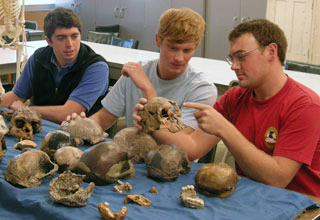Biological Anthropology

General Information
The strengths in biological anthropology are in anthropological genetics, human adaptation, behavioral ecology, and paleoanthropology. Two members of the department, along with scientists in other disciplines, offer training in human population, quantitative, behavioral and molecular genetics. Interests in historical demography and genetic epidemiology contribute to this emphasis. Research opportunities in molecular genetics are available in the Laboratory of Biological Anthropology (LBA) and in the Molecular Anthropology Laboratory (MAL). Emphasis in paleoanthropology concerns the later aspects of human evolution in Europe. Emphasis in human adaptation focuses on the evolution of human life history, integrating the study of nutrition, reproduction, growth and development. Particular attention is given to the effects of environmental/genetic interactions on the timing of life-history events. Students are encouraged to develop a biocultural framework for field-based and cross-cultural studies. Training in human genetics, molecular biology, biochemistry, human physiology/endocrinology, and quantitative methods are stressed.
Although both M.A. and Ph.D. degrees are offered in the specialization, faculty on training highly qualified students for the Ph.D. Besides academic training, the concentration stresses student participation in lab and field research. Because the program is limited to a small number of graduate students, individual training is available and encouraged.
Degree preparation includes course work in human genetics, adaptation, and paleoanthropology.

Student Support
Biological anthropologists have been successful in providing direct financial support for graduate students. Principal sources of funding include research grants, fellowships, and teaching assistantships. In recent years, most students in biological anthropology received some financial assistance and, although the availability of funds in the future is difficult to predict, the faculty hopes to maintain its fine record of student support.
Facilities
Research and training are enhanced by well-equipped facilities in population studies and paleontology. The Laboratory of Biological Anthropology contains a molecular genetics laboratory and the Midwest Twin Register. The LBA has a data bank of biological and demographic information from Australian Aborigines, Black Caribs, Hungarians, Inuit, Aleuts, Irish Travelers, Mennonites, Siberian Indigenous populations and Mexican Indian populations. In addition, extensive primate materials include dental casts, metric measurements, dermatoglyphics, and DNA specimens on 1,000 baboons, and 4,000 nonhuman primates representing the major taxa. The MAL is a 1,000 square foot, state-of-the-art molecular laboratory. The MAL is a fully equipped laboratory, and it includes: a Class II Biosafety Cabinet, a Real Time PCR machine, and a NanoDrop Spectrophotometer. The department has an extensive collection of fossil casts representing primate/human evolution from 50 million years ago to the present.